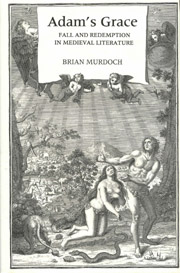Book contents
- Frontmatter
- Contents
- Ursula
- Preface
- Dedication
- Introduction: Interpreting Adam
- One After Eden: the Apocryphal Adam
- Two Written in Tablets of Stone: Adam and Gregorius
- Three Stultus et Insipiens: Adam, Parzival and the Knowledge of God
- Four Innocent Blood: Redemption and the Leper
- Five Promises to Adam: the Fall, the Redemption and Medieval Drama
- Six By the Scriptures Alone? Playing Adam in the Reformation and Beyond
- Bibliography
- Biblical Index
- General Index
Four - Innocent Blood: Redemption and the Leper
Published online by Cambridge University Press: 12 September 2012
- Frontmatter
- Contents
- Ursula
- Preface
- Dedication
- Introduction: Interpreting Adam
- One After Eden: the Apocryphal Adam
- Two Written in Tablets of Stone: Adam and Gregorius
- Three Stultus et Insipiens: Adam, Parzival and the Knowledge of God
- Four Innocent Blood: Redemption and the Leper
- Five Promises to Adam: the Fall, the Redemption and Medieval Drama
- Six By the Scriptures Alone? Playing Adam in the Reformation and Beyond
- Bibliography
- Biblical Index
- General Index
Summary
WHEN THE UNNAMED TRAVELLER is set upon on the way to Jericho, the Good Samaritan treats his wounds with oil and wine. In allegorical literature, however, the wounds require rather more than that. In Langland's Vision of Piers the Plowman, once again, even Faith and Hope – which is what the oil and the wine are usually taken as representing – have fled from the wounded traveller, and the Samaritan is left to explain the situation:
‘Haue hem excused’, quod he · ‘her help may litel auaille;
May no medcyn on molde · the man to hele brynge,
Neither Feith ne fyn Hope · so festred ben his woundis,
With-out the blode of a barn · borne of a mayde
And he be bathed in that blode · baptised, as it were,
and then plastred with penaunce · and passioun of that babi’.
A more vivid representation of the medicinal nature of Christ's blood is provided iconographically in the cathedral at Spoleto, where there is a painting by Alberto di Sozio dated 1187, depicting Christ on the Cross with the Virgin and St John. Beneath the Cross and buried deep in the hills – we look down towards it through a black opening – is a skull, a reminder of the name Golgotha, and traditionally the skull of Adam; into its open mouth flows the blood from Christ's feet in a memorable symbol of the soteriology implicit in the eucharist, curing death itself.
- Type
- Chapter
- Information
- Adam's GraceFall and Redemption in Medieval Literature, pp. 102 - 125Publisher: Boydell & BrewerPrint publication year: 2000



